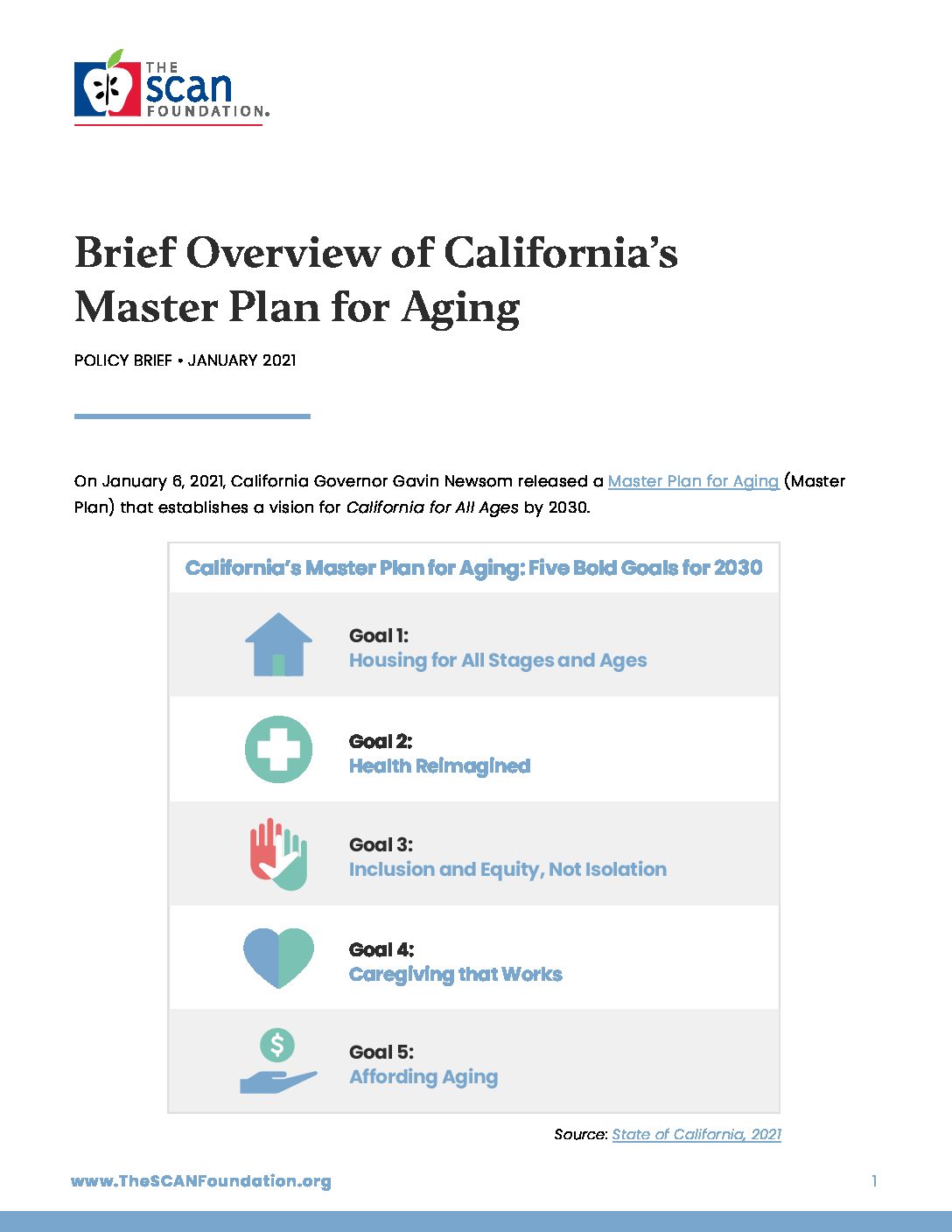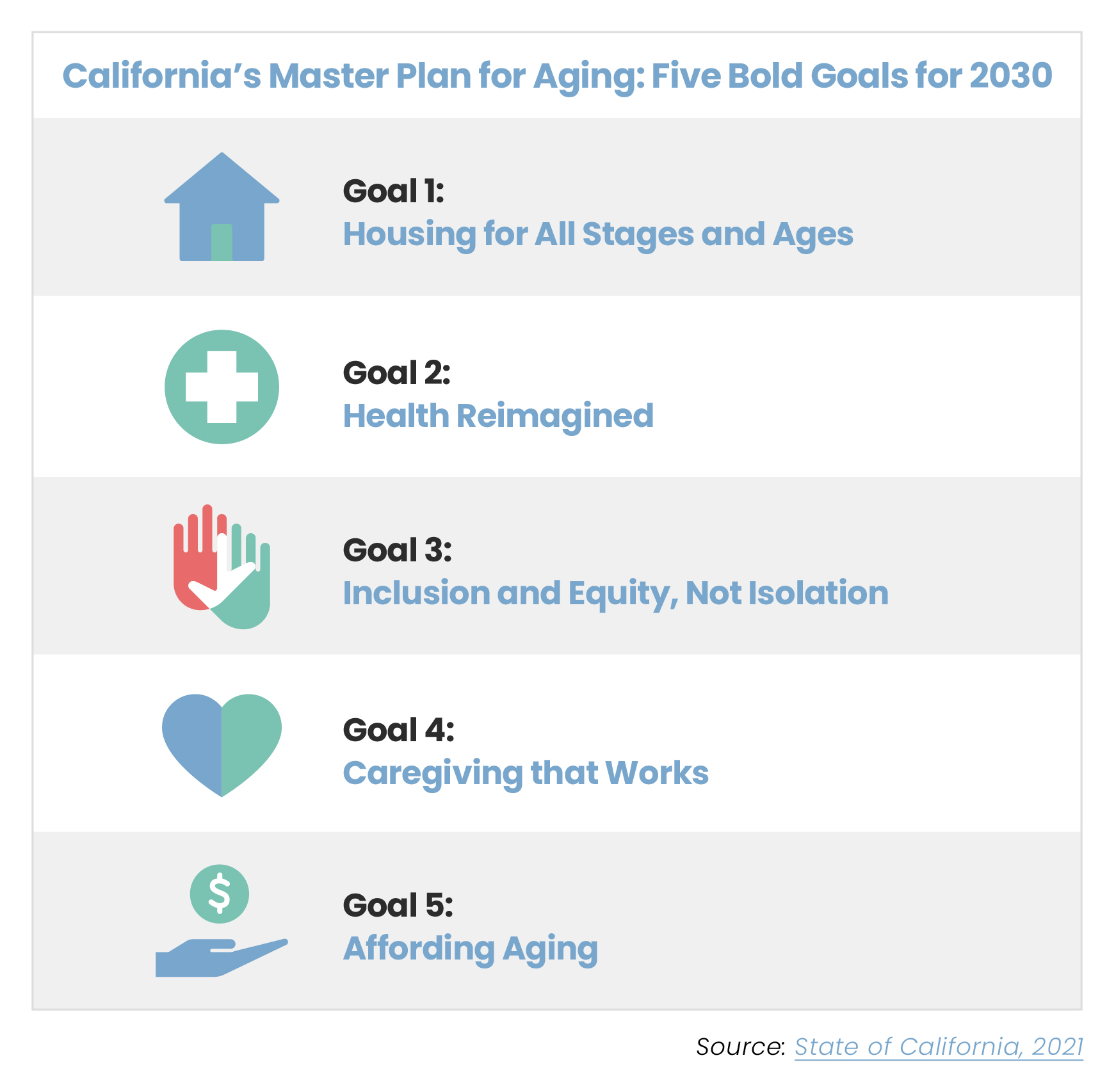Brief Overview of California’s Master Plan for Aging
summary
On January 6, 2021, California Governor Gavin Newsom released a Master Plan for Aging (Master Plan) that establishes a vision for California for All Ages by 2030. This policy brief provides an overview of the Master Plan.
Date Updated: 01/14/2021Overview
California’s population is aging, impacting the collective ability to provide and pay for the range of services needed for an increasingly diverse population of older adults and people with disabilities. This past year, COVID-19 has magnified long-standing system challenges, health disparities and inequities, while also revealing opportunities to reshape how high-quality services are delivered and financed.
On January 6, 2021, California Governor Gavin Newsom released a Master Plan for Aging (Master Plan) that establishes a vision for California for All Ages by 2030. Initiated by the governor’s call for a Master Plan in Executive Order N-14-19, the state engaged stakeholders in a 14-month planning process. Introduction of the Master Plan brings the opportunity to decisively address the needs of aging Californians through a thoughtful, comprehensive, person-centered, and outcomes-oriented strategy.
The Master Plan presents a comprehensive blueprint for public and private entities at the state, regional, and local levels to address system issues and transform services across housing, transportation, health care, and long-term services and supports. With an emphasis on equity and inclusion, the Master Plan outlines five goals with 23 strategies, and over 100 initiatives for action in the first two years of implementation.
The Master Plan offers a comprehensive blueprint for cross-sector collaborations to create a California for All Ages by 2030, emphasizing equity and inclusion through person-centered, outcomes-oriented strategies.
The Master Plan for Aging’s Five Bold Goals for 2030
| Goal 1: Housing for All Stages and Ages | |
| Target: Millions of new housing options to age well |
Strategy A: More housing options Strategy B: Transportation beyond cars Strategy C: Outdoor and community spaces for all ages Strategy D: Emergency preparedness and response Strategy E: Climate-friendly aging |
| Goal 2: Health Reimagined | |
| Target: Close the equity gap in and increase life expectancy |
Strategy A: Bridging health care with home Strategy B: Health care as we age Strategy C: Lifelong health aging Strategy D: Geriatric care expansion Strategy E: Dementia in focus Strategy F: Nursing home innovation |
| Goal 3: Inclusion and Equity, not Isolation | |
| Target: Keep increasing life satisfaction as we age |
Strategy A: Inclusion and equity in aging Strategy B: Closing the digital divide Strategy C: Opportunities to work Strategy D: Opportunities to volunteer and engage across generations Strategy E: Protection from abuse, neglect, and exploitation Strategy F: California leadership in aging |
| Goal 4: Caregiving that Works | |
| Target: One Million high-quality caregiving jobs |
Strategy A: Family and friends caregiving support Strategy B: Good caregiving jobs creation Strategy C: Virtual care expansion |
| Goal 5: Affording Aging | |
| Target: Close the equity gap in and increase elder economic sufficiency |
Strategy A: End homelessness for older adults Strategy B: Income security as we age Strategy C: Protection from poverty and hunger |
| Source: State of California, 2021 | |
Additionally, the Master Plan for Aging Local Playbook is designed for communities, private and philanthropic organizations, and government leaders to build environments that promote age-friendly and disability-friendly outcomes at the local level. The Master Plan will be updated each year through annual progress updates and recommended changes. The Data Dashboard on Aging will measure progress, providing transparency and accountability in implementation.
The key components of system planning includes five essential elements, each of which are addressed in the Master Plan, and outlined below.
How California’s Master Plan for Aging Meets the Five Essential Elements
| Decisive Leadership | Governor Newsom issued an Executive Order in 2019, calling for a Master Plan for Aging with continued leadership from the administration for its development. | |
| Rational | Goals are informed using population and data which will program also guide implementation. | |
| Comprehensive | All 10 Cabinet agencies contributed to the development of the Master Plan, and identified their lead roles on initiatives where appropriate. | |
| Stakeholder Involvement | The state formally engaged a Stakeholder Advisory Committee and three subcommittees/workgroups (Equity, Long-Term Services and Supports, and Research) through public meetings. The state also administered surveys and held additional public meetings, webinars, and community roundtables.
Moving forward, stakeholder engagement will be reimagined through development of an implementation council. |
|
| Accountability | The Data Dashboard for Aging includes a robust indicator progress dashboard. The state will provide an annual progress report used to evaluate and develop initiatives throughout the next 10 years. |
From Planning to Implementation, What’s Next?
Successful implementation of the Master Plan will require strong leadership from state and local leaders, cross-sector collaboration, and continued stakeholder involvement. Governor Newsom’s proposed 2021-22 budget included a range of investments to advance Master Plan implementation. All Californians play a role in building a state where everyone has the opportunity to age with dignity and independence. The Master Plan for Aging provides a strong platform from which to build these efforts.
Continue Reading
This policy brief provides an introduction to The SCAN Foundation’s CLASS Technical Assistance Brief Series, which explores many of the critical issues to be considered for successfully implementing CLASS.
This policy brief describes the broad needs of individuals with disability and the wide range of supportive and environmental solutions that can allow for the most independent living possible. It suggests how findings on social and environmental supports for individuals with disability can inform implementation of CLASS.
This policy brief provides background on the historical development of benefit eligibility triggers in the private long-term care insurance market. Understanding how these triggers came into being can provide important information to those charged with implementing the CLASS Plan.



